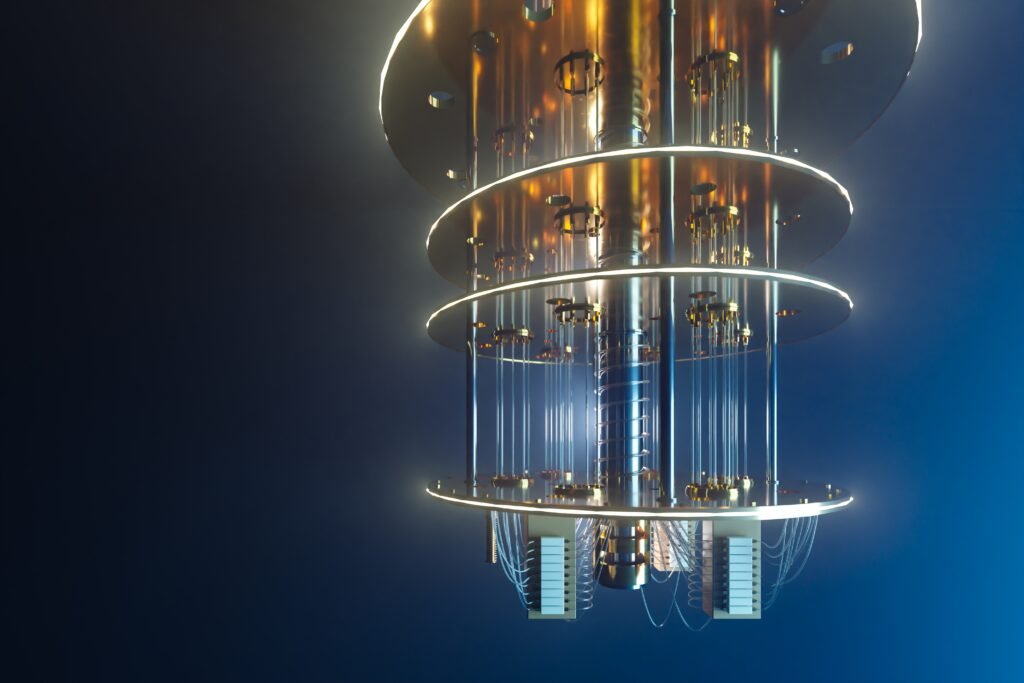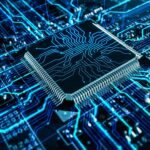Strap in, tech adventurers, for a wild ride into the frosty, futuristic realm of quantum computing hardware, where the laws of physics throw a cosmic rave and classical computers are left scratching their circuits! Quantum computers aren’t just beefed-up laptops; they’re the pickiest, most high-maintenance machines you’ll ever meet, demanding temperatures colder than a Martian winter, stillness that would make a statue jealous, and more shielding than a spaceship in a sci-fi blockbuster. These requirements come from the delicate qubits, the quantum bits that juggle multiple states like intergalactic acrobats, making quantum computers capable of solving problems that leave classical systems in the dust. Why do they look so weird and sci-fi-ish, with their gleaming cylinders and tangled pipes? Why did it take decades to build these cosmic contraptions? And why do they need to be colder than deep space and stiller than a ninja on a stealth mission? Join us for a fun, witty, and scientifically precise journey into the hardware of quantum computing, exploring the tech, the challenges, and the breakthroughs that brought us to July 18, 2025. Whether you’re a curious newbie or a scientist ready to geek out, this article’s got the lowdown on why quantum hardware is the coolest (and most sci-fi-ish) tech in the universe!
Non-Technical Explanation: Why Quantum Computers Are the Fussiest Machines in the Galaxy
Imagine a quantum computer as the ultimate tech diva, demanding a stage so cold it makes the Arctic look balmy, so quiet it shushes a whisper, and so shielded it could fend off an alien invasion. Unlike your trusty laptop, which chugs along at room temperature, quantum computers use qubits—think of them as magical, spinning orbs that can be 0, 1, or both at once, thanks to a quantum trick called superposition. But these qubits are total drama queens: a tiny bit of heat, a slight shake, or a stray signal from your Wi-Fi router can make them lose their cosmic groove, turning their quantum wizardry into a dull classical flop.
So, why the weird and sci-fi-ish look? Quantum computers often resemble glowing chandeliers or reactors from a space opera, with shiny metal cylinders hanging in giant fridges and pipes twisting like a futuristic plumbing nightmare. That’s because they need to be kept at temperatures near absolute zero (about -459°F or 15 millikelvin), colder than the void of space, to keep qubits calm and wavelike. They also need to be super still, like a ninja holding their breath during a high-stakes mission, because even a tiny tremor can ruin the show. Plus, they’re wrapped in layers of shielding to block out pesky signals like radio waves or cosmic rays zipping through the universe. Building these machines took decades—think of it as trying to teach a thousand butterflies to dance in sync during a hurricane. Recent breakthroughs, like super-cold fridges, vibration-proof setups, and sci-fi shielding, have finally let scientists keep qubits happy long enough to compute, turning quantum dreams into reality. Let’s blast off into the details!
Scientific Explanation: The Hardware of Quantum Computing
Quantum computing hardware is a triumph of engineering, designed to harness the fragile quantum states of qubits, which rely on superposition, entanglement, and quantum interference to perform computations. Unlike classical computers, which use silicon transistors to process bits (0 or 1), quantum computers manipulate qubits, which exist in a superposition of states:
[ |\psi\rangle = \alpha|0\rangle + \beta|1\rangle ]
where (\alpha) and (\beta) are complex amplitudes, and (|\alpha|^2 + |\beta|^2 = 1). This section provides a precise, detailed breakdown of the hardware requirements, the weird and sci-fi-ish aesthetics, and the challenges that delayed quantum computing for decades.
Key Hardware Components and Requirements
- Qubits: The Cosmic Core
- Types of Qubits:
- Superconducting Qubits: Used by IBM, Google, and Rigetti, these are nanoscale electrical circuits made of superconducting materials (e.g., niobium, aluminum) that conduct electricity without resistance at ultra-low temperatures. They act as artificial atoms, with energy levels representing |0⟩ and |1⟩, controlled by microwave pulses with sub-nanosecond precision.
- Trapped Ions: Employed by IonQ and Quantinuum, these use individual ions (e.g., ytterbium, calcium) held in electromagnetic traps within ultra-high vacuum chambers. Lasers manipulate their quantum states, leveraging atomic transitions for computation.
- Photonic Qubits: Used by Xanadu and PsiQuantum, these encode quantum states in photons’ properties (e.g., polarization, phase). Optical waveguides and interferometers guide photons for computation.
- Topological Qubits: Pursued by Microsoft, these aim for stability using exotic quasiparticles (e.g., Majorana fermions), but remain experimental.
- Why So Sensitive?: Qubits rely on superposition, but interactions with the environment—thermal noise, vibrations, or electromagnetic radiation—cause decoherence, collapsing the wave function to a classical state. This demands extreme conditions to maintain quantum coherence.
- Types of Qubits:
- Cryogenic Cooling: Colder Than a Black Hole’s Heart
- Requirement: Superconducting qubits require temperatures near absolute zero (~15 millikelvin, -459.67°F), colder than interstellar space (~2.7 K), to minimize thermal excitations that disrupt superposition. Trapped ions and photonic qubits tolerate slightly higher temperatures (~4 K or room temperature for photons) but still need cooling for control electronics.
- Hardware: Dilution refrigerators achieve these temperatures using a helium-3/helium-4 mixture. The fridge operates in stages:
- Outer Stage (~77 K): Cooled by liquid nitrogen.
- Middle Stage (~4 K): Cooled by liquid helium.
- Inner Stage (~10–20 mK): Dilution cooling exploits helium isotope phase separation for ultra-low temperatures.
- Sci-Fi-ish Aesthetic: The fridge is a towering, cylindrical beast (2–3 meters tall), with the quantum chip suspended at the coldest stage. Layers of polished copper or aluminum plates, connected by braided coolant pipes, give it a futuristic, reactor-like look straight out of a sci-fi flick.
- Challenges: Early dilution refrigerators were bulky, expensive (hundreds of thousands of dollars), and struggled to maintain stable millikelvin temperatures. Modern systems use advanced cryostats and automated coolant cycles for reliability.
- Vibration Isolation: Still as a Statue in a Cosmic Void
- Requirement: Qubits are hypersensitive to mechanical vibrations, which can perturb quantum states. Vibrations as small as nanometers (billionths of a meter) can cause decoherence, collapsing superposition.
- Hardware: Quantum computers use vibration isolation systems:
- Active Damping Platforms: Sensors and actuators counteract vibrations in real time, like noise-canceling headphones for motion.
- Passive Isolation: Heavy concrete slabs or air-sprung tables absorb shocks.
- Isolated Environments: Labs are built in basements or on bedrock, often in anechoic chambers to block acoustic vibrations.
- Why It Matters: A single vibration, like a footstep or distant car, can ruin a qubit’s quantum state, making it act classically. Modern systems achieve vibration amplitudes below 1 nm.
- Challenges: Early experiments lacked sufficient isolation, limiting coherence times to nanoseconds. Advances in precision engineering have extended coherence to 100–300 microseconds.
- Electromagnetic Shielding: A Force Field for Qubits
- Requirement: Qubits are disrupted by electromagnetic noise from Wi-Fi, cell signals, or cosmic rays, which induce unwanted state transitions. Even a single microwave photon can collapse superposition.
- Hardware: Quantum processors are encased in mu-metal shields (high-permeability alloys like nickel-iron) and superconducting enclosures to block magnetic and electric fields. The system is often housed in a Faraday cage, a grounded metal enclosure that deflects external signals.
- Sci-Fi-ish Aesthetic: The shielding layers, combined with dense coaxial cables for control signals, create a chaotic, futuristic look—like a spaceship’s engine room. The quantum chip, suspended in a vacuum chamber, resembles a glowing artifact from a sci-fi epic.
- Challenges: Early systems suffered from inadequate shielding, leading to error rates of 10–20% per gate. Modern shielding reduces errors to 0.1–1%, though cosmic rays remain a persistent challenge.
- Control Systems: Precision Like a Laser-Guided Starship
- Requirement: Qubits are manipulated using precise signals—microwaves for superconducting qubits (5–10 GHz), lasers for trapped ions (visible or UV wavelengths), or optical pulses for photonic qubits—to perform quantum gates (e.g., Hadamard, CNOT).
- Hardware: Arbitrary waveform generators and high-precision lasers deliver signals with sub-nanosecond accuracy. Cryogenic wiring (e.g., superconducting coaxial cables) routes signals to the qubits without introducing heat or noise. Attenuators and filters in the fridge reduce signal distortion.
- Challenges: Early control systems lacked the precision for high-fidelity gates, and wiring introduced noise. Modern systems use cryogenic electronics and advanced signal processing to achieve gate fidelities of 99.9% or higher.
- Quantum Processor Layout: A Circuit Board from the Future
- Design: The quantum processor, or quantum chip, is a small (1–5 cm²) chip hosting qubits and their connections. Superconducting chips use Josephson junctions (nonlinear inductors) for qubit functionality. Trapped ion systems use vacuum chambers with electromagnetic traps, while photonic systems use optical waveguides and interferometers.
- Sci-Fi-ish Aesthetic: The chip, suspended in the dilution refrigerator’s coldest stage, is surrounded by a tangle of cables, shielding, and vacuum chambers, looking like a futuristic relic in a high-tech cocoon.
- Challenges: Scaling from tens to thousands of qubits increases crosstalk (unwanted qubit interactions) and noise. Modern layouts use 2D or 3D architectures with precise calibration to minimize errors.
Why Quantum Hardware Looks So Weird and Sci-Fi-ish
Quantum computers’ distinctive appearance—gleaming cylinders, snaking pipes, and glowing chambers—stems from their extreme requirements:
- Dilution Refrigerator: The towering, cylindrical fridge with coolant pipes resembles a reactor from a sci-fi blockbuster, necessary for millikelvin temperatures.
- Shielding and Wiring: Mu-metal shields, superconducting enclosures, and dense cabling for control signals create a chaotic, spaceship-like aesthetic.
- Suspension Systems: Qubits are suspended in vacuum chambers or on vibration-damped platforms, adding to the futuristic, floating-artifact vibe.
- Scale: Unlike sleek laptops, quantum computers are room-sized behemoths, with fridges, control electronics, and shielding dominating the setup, evoking a sci-fi command center.
This weird and sci-fi-ish look is a direct result of coddling qubits in an environment where even a whisper of disturbance can derail their quantum magic.
Why It Took So Long to Get Here
Building quantum hardware was a decades-long odyssey due to qubits’ fragility and the precision required:
- Decoherence: Early qubits lost superposition in nanoseconds due to thermal, vibrational, or electromagnetic noise. Achieving coherence times of 100–300 microseconds required advances in materials (e.g., ultra-pure silicon, niobium) and cooling technologies.
- Error Rates: Early quantum gates had error rates of 10–20%, far too high for reliable computation. Modern systems achieve 0.1–1% error rates through improved fabrication and surface code error correction, which uses redundant qubits to protect quantum states.
- Scalability: Early systems had 1–5 qubits, insufficient for practical applications. Scaling to 50–1000 qubits demanded innovations in qubit connectivity, noise management, and chip design.
- Materials and Fabrication: Qubits require exotic materials (e.g., superconducting alloys, single-ion traps) and nanoscale precision, only recently achievable through advances in nanotechnology and cleanroom fabrication.
- Control Systems: Precise manipulation of qubits required high-fidelity electronics, developed in the 2010s–2020s with cryogenic-compatible hardware.
Historical Milestones
- 1980s–1990s: Early qubit experiments using nuclear magnetic resonance (NMR) demonstrated superposition but were unscalable due to weak quantum effects at room temperature.
- 2001: IBM’s 7-qubit NMR computer factored 15 using Shor’s algorithm, but relied on liquid samples, not solid-state hardware.
- 2011: D-Wave’s quantum annealer used superconducting qubits for optimization, though limited to specific tasks.
- 2016: IBM’s Quantum Experience provided cloud access to a 5-qubit superconducting system, showcasing cryogenic hardware and shielding.
- 2019: Google’s 53-qubit Sycamore achieved quantum supremacy, performing a random circuit sampling task in 200 seconds (vs. 10,000 years for classical supercomputers), enabled by advanced dilution refrigerators and vibration isolation.
- 2020: USTC’s Jiuzhang used photonic qubits in a room-temperature setup with optical waveguides, demonstrating quantum advantage in boson sampling.
- 2023: IBM’s 433-qubit Osprey processor scaled superconducting qubits, with improved coherence times (100–200 µs) and error rates (~0.1%) due to better shielding and control.
- 2025 (Current): Systems with 50–1000 qubits (e.g., IBM, IonQ, Rigetti) use state-of-the-art hardware to maintain superposition, enabling prototype applications in quantum chemistry, finance, and optimization.
Recent Breakthroughs (2015–2025)
- Coherence Times: Advances in dilution refrigerators and materials (e.g., high-purity superconductors) extend coherence times to 100–300 µs, allowing longer quantum computations.
- Error Correction: Surface codes and dynamical decoupling reduce gate errors, protecting superposition against decoherence.
- Scalability: Modular architectures and 3D chip designs enable systems with hundreds of qubits, with IBM targeting 1000+ qubits by 2026–2028.
- Control Systems: High-fidelity microwave and laser systems, combined with cryogenic electronics, achieve gate fidelities of 99.9%, minimizing noise.
- Shielding: Advanced mu-metal and superconducting enclosures block cosmic rays and electromagnetic noise, reducing error rates.
- Berkeley’s Contributions: UC Berkeley researchers have improved coherence in superconducting qubits, developed error correction techniques, and explored photonic systems, enhancing hardware reliability.
Implications for Quantum Computing
Quantum hardware’s extreme requirements enable qubits to perform feats unattainable by classical computers:
- Superposition: Allows qubits to represent (2^n) states for (n) qubits, enabling exponential parallelism for algorithms like Shor’s (cryptography) and Grover’s (search).
- Entanglement: Creates correlations for complex computations, like quantum simulation for drug discovery.
- Applications: Prototype systems tackle quantum chemistry (e.g., molecular modeling), optimization (e.g., logistics), and cryptography, with hardware enabling stable quantum states.
- Challenges: Decoherence, errors, and scalability remain hurdles, requiring ongoing innovation in cooling, isolation, and shielding.
Current State and Future Outlook (July 18, 2025)
As of July 18, 2025, quantum computing is in the Noisy Intermediate-Scale Quantum (NISQ) era, with systems of 50–1000 qubits leveraging advanced hardware. Key developments include:
- Applications: Prototypes in drug discovery (e.g., Merck), finance (e.g., JPMorgan Chase), and logistics (e.g., DHL) rely on stable qubits.
- Hardware: IBM, Google, IonQ, and others use dilution refrigerators, vibration isolation, and shielding to maintain superposition. IBM aims for 1000+ qubits by 2026–2028.
- Challenges: Reducing errors and scaling qubits while keeping the sci-fi-ish setup manageable.
Future Outlook:
- Near-term (5–10 years): Improved hardware will enable hybrid quantum-classical systems for optimization and small-scale simulations, like a warm-up act for the quantum revolution.
- Long-term (10–20 years): Fault-tolerant quantum computers with thousands of stable qubits could crack encryption, revolutionize materials science, and jam alongside classical systems in a tech symphony.
Conclusion
Quantum computing hardware is a weird and sci-fi-ish marvel, with its gleaming dilution refrigerators, tangled pipes, and shielded qubit chambers straight out of a space opera. The need for near-absolute-zero temperatures, ninja-like stillness, and cosmic-ray-proof shielding stems from the fragile nature of qubits, which rely on superposition to perform quantum magic. Decades of challenges—decoherence, high error rates, and scaling woes—delayed progress, but breakthroughs in cryogenics, vibration isolation, and shielding have made quantum computers a reality. As of 2025, systems with hundreds of qubits are tackling real-world problems, with the promise of transforming industries. So, next time you see a quantum computer’s futuristic glow, remember: it’s not just sci-fi flair—it’s the key to unlocking the universe’s computational secrets!



Leave a Reply